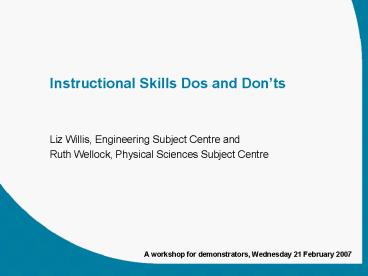Instructional Skills Dos and Donts - PowerPoint PPT Presentation
1 / 7
Title:
Instructional Skills Dos and Donts
Description:
8. Drink out of a tall, mug-shaped tea cup. 9. Don't add ... Can you replicate the perfect cup of tea using the equipment available in most student kitchens? ... – PowerPoint PPT presentation
Number of Views:83
Avg rating:3.0/5.0
Title: Instructional Skills Dos and Donts
1
Instructional Skills Dos and Donts
- Liz Willis, Engineering Subject Centre and
- Ruth Wellock, Physical Sciences Subject Centre
2
How to make a perfect cuppa
- GEORGE ORWELL'S TEA RULES
- 1. Use tea from India or Ceylon (Sri Lanka), not
China - 2. Use a teapot, preferably ceramic
- 3. Warm the pot over direct heat
- 4. Tea should be strong - six spoons of leaves
per 1 litre - 5. Let the leaves move around the pot - no bags
or strainers - 6. Take the pot to the boiling kettle
- 7. Stir or shake the pot
- 8. Drink out of a tall, mug-shaped tea cup
- 9. Don't add creamy milk
- 10. Add milk to the tea, not vice versa
- 11. No sugar!
- http//news.bbc.co.uk/1/hi/uk/3016342.stm
3
The perfect modern cuppa
- Can you replicate the perfect cup of tea using
the equipment available in most student kitchens?
4
- You have 15 mins to prepare a 3 minute
demonstration of how to make a cup of tea for the
group. At least 2 members of the group must be
involved in the actual demonstration. - Or
- Start by considering what makes a good
demonstration. Generate a list of 10 marking
criteria on which to assess the demonstrations.
5
Preparation
- familiarising yourself with laboratory and
equipment for the experiment - Try the experiment yourself before the session
- ensure that any necessary equipment is in place
and working - Make sure you have clear guidelines on what is
required of students - Check if any of the students have specific
learning difficulties you need to be aware of
6
Giving Instructions
- Use an Effective Introduction
- Start with an outline of what you are going to
do, explain why it is important set the tone, - Organize your presentation clearly and simply
- Prioritize topics - what is obvious to you may
not be obvious to the students - Use simple language but dont talk down to the
students - Sound enthusiastic
- Analyze the Environment
- check out size of room, placement of chairs, time
of day, temperature, distractions - Don't block visual aids
- Talk to the audience not the equipment
- Create an Effective Conclusion
- Summarize the key points of the demonstration
- Consider support materials as memory aids
7
References
- Tutoring and Demonstrating A Handbook, chapter 5
- Demonstrating, Iain Allison - http//www.tla.ed.ac.uk/resources/tut-dem/Chap5.pd
f































